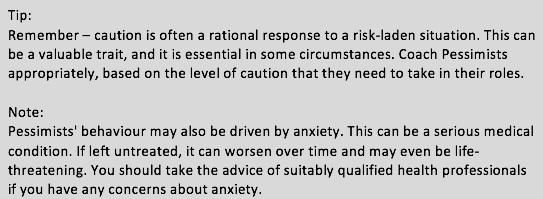
However talented your people are, some of them may display behaviours that hold them back. Not only do they hold them back, but they can be difficult for team leaders to know how to manage.
Sometimes, as a team leader, you know something isn’t helpful, but you have never been able to name it. Once you are able to name’ something then you can develop some strategies to deal with it effectively.
The problem behaviours aren’t always immediately difficult to manage, over time however they often become more and more problematic. For instance, one employee might focus too intensely on potential problems. Another might consistently take on too much work, while another may achieve great things at the expense of his colleagues’ feelings.
These people probably have the best of intentions: they want to deliver to the highest standard, and they honestly believe that they’re doing this. But the behaviours that they have developed can undermine their effectiveness, damage team morale, and even stall their careers.
In this article, we’ll look at six problem behaviours that business psychologists have identified in people who are doing their honest best. We’ll also examine what you can do to help these people learn more positive behaviours.
Overview
Psychologists James Waldroop and Timothy Butler identified a number of behaviours that commonly hurt people’s careers, and they described them in their Harvard Business Review article, “Managing Away Bad Habitsâ€. (2000). They later drew out six of the most troublesome traits, and assigned each an easy-to recognize “character.” These are:
- The Hero.
- The Meritocrat.
- The Bulldozer.
- The Pessimist.
- The Rebel.
- The Home Run Hitter.
From “Managing Away Bad Habits” by James Waldroop and Timothy Butler. Published by Harvard Business Review, September 2000.

The Six Characters and Their Problem Behaviours
Let’s look at the six characters – and the traits that they display – in more detail. We’ll then outline how you can coach your people to learn new, more positive behaviours instead.
1.The Hero
Most managers love to have a Hero on their team. Driven by personal and organizational success, Heroes constantly push themselves and others to complete projects on time and on quality, producing top results.
But Heroes can push themselves too far and burn out. Â They can also have trouble retaining staff, because only some people can tolerate the heavy workloads that Heroes expect.
To spot Heroes, look at your high achievers. They’re often the first to arrive at the office, and the last to leave.
Coaching Heroes
When coaching Heroes, your aim is not to stop their Heroic behaviour, but to prevent it from damaging themselves and others.
So, start coaching conversations with Heroes by communicating your appreciation for their good work, but then move on to discuss your concern for their well-being. Let your Heroes know that they need to slow down occasionally. Outline specific problem behaviours – such as working overly long hours – so that they understand how their actions can harm themselves and the people around them.
Heroes may be pushing their staff members to the brink as well. Many Heroes focus on achieving goals rather than meeting others’ needs, so it’s important that they develop empathy toward their staff.
Heroes might be approaching burnout, even if they don’t realize it. Advise them to assess their levels of burnout and help them avoid burnout by suggesting time off or delegating some of their workload.
Heroes may also need help reading others’ subtle cues. Advise them to listen to their own people closely, so that they’re sensitive to signs of overwork, such as resistance to new tasks. If you suspect that they’re overworking their teams, advise them to pull back. Likewise, if they frequently contact their staff during off hours, put a stop to this.
2.The Meritocrat
Meritocrats believe that the best ideas stand on their own; and they don’t instinctively understand why they should have to “sell” or reshape an idea to meet others’ expectations. They loathe office politics, and they’re often poor negotiators, because they find it frustrating to get buy-in for their ideas.
Meritocrats are usually hard working and intelligent, and they have a great deal of integrity. Despite this, their careers often stall. Their lack of political savvy overshadows their talent, meaning that others are promoted ahead of them. They may also be unwilling to sell their ideas to key stakeholders, restricting their own visibility within their organization.
Coaching Meritocrats
Start with sympathy. Let Meritocrats know that you understand their perspective that “politicking” can feel like a waste of time.
Remind them that their ideas can only progress if decision makers are on board, and that building alliances and selling ideas are an essential part of this process. Then explain how they can do this without sacrificing their integrity. For example, they could use Stakeholder Analysis and an influence model, both of which encourage honest, effective communication.
Next, focus on one of their recent ideas. Outline how they can win over key stakeholders and potential allies, and help them uncover what drives those people, so that they can design an approach with them in mind.
3.The Bulldozer
Bulldozers accomplish their goals at all costs. However, they can intimidate and alienate others in pursuit of goals; their peers might even describe them as “mean.” They distrust others, and, therefore, others don’t trust them.
On the other hand, Bulldozers are often effective, which is why they continue their behaviour. But, over time, this behaviour lowers team morale and decreases everyone’s effectiveness. Bulldozers, like Heroes, often have high staff turnover within their teams.
Coaching Bulldozers
Approach Bulldozers by becoming one yourself – just temporarily. Speak bluntly and let them know that they’ve made office enemies.
Waldroop and Butler found the following statement effective: “If I put it to a vote, there’s no question. You’d be fired.” However, use your best judgment to decide how to phrase this conversation. It’s essential not to discourage Bulldozers from being passionate and energetic – they simply need to channel their drive in more positive ways.
Gather evidence to rebut any protests, and be ready to cite examples that show how your Bulldozers have bullied or alienated colleagues. Ensure that they know the consequences of a refusal to change.
Once Bulldozers are ready to listen, encourage them to right their wrongs. Explain how they can use apologies to rebuild their damaged relationships, and help them script apologies tailored to the people whom they have mistreated. Use role-play exercises to practice these difficult conversations.
Also discuss the triggers for bullying behaviour: What situations cause them to act in this way? Suggest that when they experience a trigger, they leave the room and practice deep breathing or focus on a positive affirmation.
Again, role-playing can help your Bulldozers become comfortable with this changed behaviour.
4.The Pessimist
Pessimists oppose any change; they are the naysayers who urge caution for even the smallest decisions.
They’re largely driven by fear. As a result, they work to avoid mistakes and failures, and, because of this, they can stifle not only their own creativity, but other people’s as well.
Coaching Pessimists
Despite fearing change, most Pessimists care deeply about their team and organization. Their cautious behaviour – on an appropriate scale – can be very useful, particularly in quality-related areas, in health and safety, and in industries where there are high levels of physical, operational or financial risk.
Open a coaching conversation by recognizing the value of caution, but then move on to help them understand how damaging excessive worry can be. Not only can it lead to anxiety, but it can also affect a team’s effectiveness and morale.
Pessimists may oppose changes because they don’t understand them. Encourage Pessimists to compare the risks of doing nothing with those of making a specific change.
Next, help Pessimists understand their risk propensity, so that they can better comprehend the “why” behind their caution.
Finally, Pessimists may micromanage because they’re afraid to trust others with important tasks. Help them to avoid micromanage by encouraging them to delegate tasks.

5.The Rebel
Rebels defy authority at every turn. They may complain about company policies or management (yet do little about it), make cynical jokes about the company, or question change.
You’ll find that managing these people can be challenging: They may do useful work, but their attitude can undermine team morale. Their negativity can infect others, and they can even change an organization’s culture, over time.
Rebels can often have great leadership potential, however. They recognize where change is needed, and they have the energy and passion to effect it. But they often need a firm hand and an inspiring coach to transform their negative energy into a force for positive change.
Coaching Rebels
Remember that Rebels thrive on provocation. Thus, when confronting Rebels about their behaviour, managing your emotions is key. Stay calm, and make sure that you’re assertive.
Assign Rebels projects that call for them to win others over. When they’re forced to focus on the positives of a project in order to sell it, Rebels have to challenge their own negative attitude. In addition, many Rebels love to complain, but they’ll often change their attitude when they hear other people’s viewpoints.
When Rebels refuse to do a project, take another approach: Ask them – without emotion or blame – if they’re planning to quit. Explain that their attitude conveys that they’re ready to leave. They will likely respond with disbelief or tell you that they’re not interested in quitting. Then, tell them that you will no longer tolerate their complaints, especially when there’s nothing that can be done about them.
Challenge Rebels to write down everything that they believe the organization should change. Also, have them study the corporation’s culture for a week or two by tracking how people dress, interact, and communicate. Make it clear that fitting in with the corporate culture and learning how to work with people, not against them, is a useful first step to addressing anything on their list.
6.The Home Run Hitter
Home Run Hitters work for the approval of their boss and colleagues. Like Heroes and Bulldozers, they may land the biggest clients or make huge sales, but unlike these characters, Home Run Hitters are motivated by a need for approval, rather than by personal or organizational goals.
Hitters are successful, but they often bite off more than they can chew. As such, they can damage both their own prospects, and their team’s success, by “going big” when a smaller action would have been more appropriate.
Coaching Home Run Hitters
Start by communicating how much you appreciate your Hitters’ hard work and success. Reassure them that they’re already on track to reach their goals, but that you need to see them get there at a healthy pace.
Sit down with Hitters to discuss their career strategy and development ideas. Where do they ultimately want to be in the organization?
Explain that individuals currently serving in Hitters’ ideal roles didn’t get there overnight; instead, years of experience and proven steady delivery came first. It’s natural that they want to realize their goals immediately, but by rushing full-steam ahead and focusing on short-term approval, they’re missing out on valuable learning experiences. This could jeopardize their ability to progress.
It’s also essential to stress the importance of risk anaylsis to Home Run Hitters. If they want to secure long-term approval, they need to show that they’re a “safe pair of hands” – that they can assess risks carefully and make informed decisions before embarking on a project. Risk analyses also provide opportunities for reflection, which can help Home Run Hitters slow down and think more carefully.
Encourage Hitters to put the team’s success first: How can they help others succeed? Explain the benefits of positive teamwork, and discuss how developing a reputation, as a team player will enable them to achieve their goals.
DO YOU HAVE ANY OF THESE PEOPLE ON YOUR TEAM? HOW ARE YOU MANAGING THEM SUCCESSFULLY? I WOULD LOVE YOUR FEEDBACK


